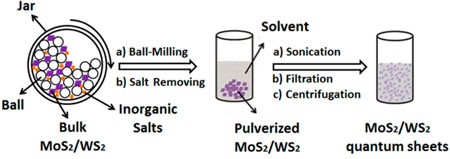| Posted: Nov 30, 2017 | |
High-yield production of intrinsic and defect-free MoS2 and WS2 2-D sheets(Nanowerk News) Two-dimensional (2D) materials have attracted much attention over the past ten years. However, most of the research has focused on their micro/nanosheets. Recently, 2D materials with further reduced dimensions, e.g., nanoribbons, quantum dots, and quantum sheets, have emerged. With lateral sizes of approximately <20 nm, quantum sheets could be imparted with not only the intrinsic characteristic of 2D materials but also quantum confinement and prominent edge effects. |
|
| To date, there is still lacking a method for the mass production of intrinsic QSs of TMDs. In a new paper published in Nano Letters ("High-Yield Production of MoS2 and WS2 Quantum Sheets from Their Bulk Materials"), researchers from China report a general strategy for the high-yield production of MoS2 and WS2 QSs with intrinsic and defect-free characteristics, which was achieved by sequential combination of salt-assisted ball-milling and sonication-assisted solvent exfoliation of the bulk materials. | |
| The fabrication process of the MoS2 and WS2 QSs is illustrated in the figure below. | |
 |
|
| Schematic illustration of the fabrication process. (© ACS) | |
| The scientists emphasize that dry milling rather than wet milling was employed to maximize the pulverization of the bulk materials. The introduction of inorganic salts such as sodium chloride (NaCl) and many others into the ball-milling process played a key role as well. | |
| Such salt-assisted ball-milling pushed the pulverization to an unprecedented level. The following sonication-assisted solvent exfoliation transformed the pulverized materials into MoS2 and WS2 quantum sheets. | |
| After filtration and centrifugation, highly stable dispersions of the quantum sheets in N-methyl-2-pyrrolidone were obtained. | |
| A single cycle of the above fabrication process enabled production of MoS2 and WS2 quantum sheets from their bulk materials with high yields of 25.5 and 20.1 wt %, respectively, which was 1-2 orders of magnitude higher than that reported previously. | |
| "The demonstration of nearly an order of magnitude enhancement in modulation depth of nonlinear absorption saturation of the quantum sheets-PMMA compared with the micro/nanosheets-PMMA," the authors conclude their report. |
 By
Michael
Berger
– Michael is author of three books by the Royal Society of Chemistry:
Nano-Society: Pushing the Boundaries of Technology,
Nanotechnology: The Future is Tiny, and
Nanoengineering: The Skills and Tools Making Technology Invisible
Copyright ©
Nanowerk LLC
By
Michael
Berger
– Michael is author of three books by the Royal Society of Chemistry:
Nano-Society: Pushing the Boundaries of Technology,
Nanotechnology: The Future is Tiny, and
Nanoengineering: The Skills and Tools Making Technology Invisible
Copyright ©
Nanowerk LLC
|
|
|
Subscribe to a free copy of one of our daily Nanowerk Newsletter Email Digests with a compilation of all of the day's news. |
